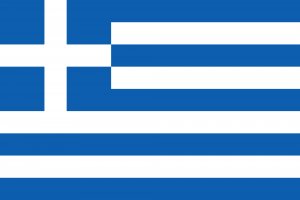Language/Modern-greek-1453/Culture/Greek-art-and-architecture
As a Modern Greek language teacher, I believe it is essential for my students to not only learn the language itself but also the culture and history behind it. Greek art and architecture are key components of the country's rich heritage and have contributed to shaping Western culture. In this lesson, we will explore the evolution of Greek art and architecture throughout time, from ancient Greece to the Modern Greek era.
Consider broadening your understanding by checking out these related lessons: Figures of Speech Asyndeton Schema & Kourabiedes: Greek shortbread cookies with almonds.
Ancient Greece
Greek art and architecture are well-known from the Ancient Greek period, which lasted from the 8th century BC to the 6th century AD. During this time, architecture took on a monumental scale, with impressive buildings such as the Parthenon in Athens or the Temple of Apollo in Delphi, which still stand today. Greek sculpture was also renowned for its realistic portrayal of the human form, as seen in the famous statue of Nike of Samothrace or the Venus de Milo.
||| {| class="wikitable" ! Modern Greek (1453-) !! Pronunciation !! English |- | Παρθενώνας (Parthenónas) || [paɾ.te.ˈno.nas] || Parthenon |- | Νίκη της Σαμοθράκης (Níki tis Samothrákis) || [ˈni.ci tis sa.mo.ˈθra.cis] || Nike of Samothrace |- | Αφροδίτη της Μήλου (Afrodíti tis Mílou) || [af.roˈði.ti tis ˈmi.lu] || Venus de Milo |}
Byzantine Empire
The Byzantine Empire was the continuation of the Roman Empire in its eastern provinces, and it lasted from the 4th century AD to the 15th century AD. During this time, the focus shifted from monumental architecture to religious art, with beautiful mosaics and frescoes adorning the walls of churches and monasteries. The Byzantine Empire was also known for its distinctive architectural style, characterized by domes and rounded arches, as seen in the Hagia Sophia in Istanbul, Turkey, which was once a Byzantine church.
||| {| class="wikitable" ! Modern Greek (1453-) !! Pronunciation !! English |- | Αγία Σοφία (Agía Sofía) || [a.ˈʝa so.ˈfi.a] || Hagia Sophia |- | Μωσαϊκά (Mosaïká) || [mo.sa.ˈi.ka] || Mosaics |- | Τοίχοι της Παναγίας (Toíchoi tis Panagías) || [ˈto.i.xi tis pa.na.ˈʝi.as] || Walls of the Virgin Mary |}
Ottoman rule
During the Ottoman rule from the 15th century to the early 19th century, the architecture in Greece took on a more functional and simpler style, as the conquerors did not encourage the construction of lavish buildings. However, mosques and public baths were built, such as the famous Mosque of the Janissaries in Athens, which is still standing today. The influence of Ottoman architecture can also be seen throughout the rest of Greece with the prevalence of Ottoman fountains.
||| {| class="wikitable" ! Modern Greek (1453-) !! Pronunciation !! English |- | Τζαμί των Γενίτσαρων (Tzámi ton Genítsaron) || [ˈd͡ʒa.mi ton ʝe.ˈni.t͡sa.ɾon] || Mosque of the Janissaries |- | Τούρκικες κρήνες (Toúrkikes krínes) || [ˈtuɾ.ci.kes ˈkɾi.nes] || Ottoman Fountains |}
Modern Greece
After the War of Independence in 1821, Greece gained its independence from the Ottoman Empire and underwent a revival of its cultural identity. This is evident in the construction of public buildings and monuments all throughout the country, such as the Zappeion in Athens or the White Tower in Thessaloniki, which are examples of neoclassical architecture. In literature, renowned Greek writers such as Nikos Kazantzakis and Giorgos Seferis contributed to the country's literary heritage.
||| {| class="wikitable" ! Modern Greek (1453-) !! Pronunciation !! English |- | Ζάππειο (Záppeio) || [ˈza.pi.o] || Zappeion |- | Λευκός Πύργος (Lefkós Pýrgos) || [lef.ˈkos ˈpiɾ.ɣos] || White Tower |- | Νίκος Καζαντζάκης (Níkos Kazantzákis) || [ˈni.kos ka.zan.ˈt͡sa.kis] || Nikos Kazantzakis |- | Γιώργος Σεφέρης (Giórgos Seferis) || [ˈʝor.ɣos se.fe.ˈris]|| Giorgos Seferis |}
Greek art and architecture are a testament to the country's rich cultural heritage and have had a significant impact on Western civilization. Through the ages, the Greeks have demonstrated their creativity and versatility, producing some of the most remarkable art and architecture in the world. By studying these works, we can learn more about Greek culture and understand its impact on our society today.
Sources
Other Lessons
- The diverse fauna of Greece
- The Rapture of Europe
- Greek Proverbs
- Playing in Ancient Greece
- Ηistorical period of Greek language
- Poetry
- The mysterious origins of punctuation
- Allegory in Art and Literature
- Pre Socratic Philosophers
- Ο Γαλαξίας

